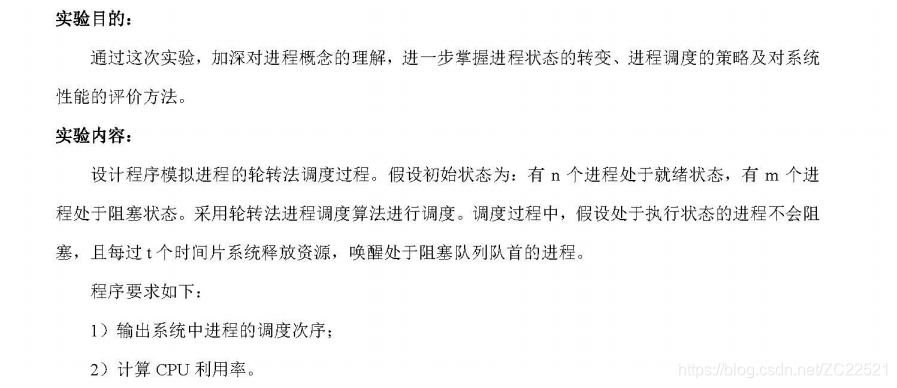
实验源代码:
#include <iostream>
#include<ctime>
using namespace std;
//共有n个进程就绪,m个进程阻塞
//经过t个时间片释放系统资源,唤醒处于阻塞队列队首的进程
/*每个时间片大小为1,进程所需CPU时间为整数*/
struct PCB_type {
char name;//进程名
int statr;//进程状态 2执行,1就绪,0阻塞
int cpu_time;//运行需要CPU时间
};
struct QueueNode {
PCB_type PCB;
QueueNode* next;
};
const int T = 5;//每过五个时间片,将阻塞队列中的进程放入就绪队列中
const int Timeslice = 2;//一个时间片大小
const int N = 5;//N为所有PCB进程的个数,0<N<26,对PCB进程命名为26个英文字母
double cpu_whole = 0;//总共用了多少个时间片
double cpu_free = 0;//空闲的时间片
QueueNode* ready_head = new QueueNode();//就绪队列头节点
QueueNode* blocked_head = new QueueNode();//阻塞队列头节点
QueueNode* node_tail = new QueueNode();//两个队列的尾部节点
//向队列尾部插入节点
void addNode(PCB_type pcb)
{
QueueNode* Queue=node_tail;
if (pcb.statr == 1)
{
Queue = ready_head;//就绪
}
else if (pcb.statr == 0)
{
Queue = blocked_head;//阻塞
}
//暂时不处理进程处于执行状态
else
{
cout << "进程正在执行" << endl;
}
while (true)
{
if (Queue->next == node_tail)
{
break;
}
Queue = Queue->next;
}
QueueNode* Q = new QueueNode();
Q->PCB = pcb;
Q->next = Queue->next;
Queue->next = Q;
}
//取出节点
//n=1取出就绪队列中节点执行后放入就绪队列末尾或者直接释放,
//n=2取出阻塞队列中节点放入就绪队列末尾
void delNode(int n)
{
//PCB_type PCB;
if (n == 1)
{
//取出就绪队列中节点,判断进程是否执行完,
//未执行完则放入就绪队列末尾,否则删除
//判断就绪队列是否为空,为空时不做操作
if (ready_head->next != node_tail)
{
//减去一个时间片大小
if ((ready_head->next->PCB.cpu_time-Timeslice) > 0)
{
//在时间片执行完后剩余运行所需CPU时间>0,将进程放入就绪队列末尾
ready_head->next->PCB.cpu_time -= Timeslice;
addNode(ready_head->next->PCB);
ready_head->next = ready_head->next->next;
}
else
{
//在时间片执行完后进程结束,销毁进程
ready_head->next = ready_head->next->next;
}
}
else
{
cpu_free++;
}
}
else if(n==2)
{
//将阻塞队列头部的进程放入就绪队列末尾
//阻塞队列头部后移一个
//判断阻塞队列是否为空,若为空则不操作
if (blocked_head->next != node_tail)
{
blocked_head->next->PCB.statr = 1;
addNode(blocked_head->next->PCB);
blocked_head->next = blocked_head->next->next;
}
}
else
{
cout << "参数错误" << endl;
}
}
void out()//输出两个队列中所有的进程
{
QueueNode* Queue = new QueueNode();
cout << "就绪队列" << endl;
Queue = ready_head;
while (Queue->next!=node_tail)
{
cout << Queue->next->PCB.name <<"剩余长度"<<Queue->next->PCB.cpu_time<< endl;
Queue = Queue->next;
}
cout << "阻塞队列" << endl;
Queue = blocked_head;
while (Queue->next != node_tail)
{
cout << Queue->next->PCB.name << endl;
Queue = Queue->next;
}
cout << endl;
}
void start()
{
ready_head->next = node_tail;
blocked_head->next = node_tail;
//对PCB进行初始化
//使用PCB数组进行存储全部进程
srand(time(0));//随机数种子
PCB_type pcb[N];//定义N个PCB进程
char Name = 'A';
string temp = "阻塞";
cout << "全部PCB进程如下" << endl;
//创建PCB进程
for (int i = 0;i < N;i++)
{
pcb[i].cpu_time = rand() % 10 + 1;
pcb[i].statr = rand() % 2 + 0;//进程状态不考虑执行状态即状态码不为2
pcb[i].name = Name;
Name++;
if (pcb[i].statr == 1)
{
temp = "就绪";
}
cout << "进程名称" << pcb[i].name << "进程所需CPU时间" << pcb[i].cpu_time << "进程状态" << temp << endl;
}
for (int i = 0;i < N;i++)
{
addNode(pcb[i]);
}
out();
}
int main()
{
int a = 0;
start();
while (ready_head->next != node_tail && blocked_head != node_tail)
{
for (int i = 0;i < 5;i++)
{
delNode(1);
if (ready_head->next == node_tail && blocked_head == node_tail)
{
//就绪队列和阻塞队列都空
break;
}
cpu_whole++;
}
delNode(2);
out();
}
cout << "CPU总占用时间" << cpu_whole << "CPU空闲时间" << cpu_free << endl;
cout << "CPU利用率" << 1 - (cpu_free / cpu_whole) << endl;
}




















 2151
2151











 被折叠的 条评论
为什么被折叠?
被折叠的 条评论
为什么被折叠?








